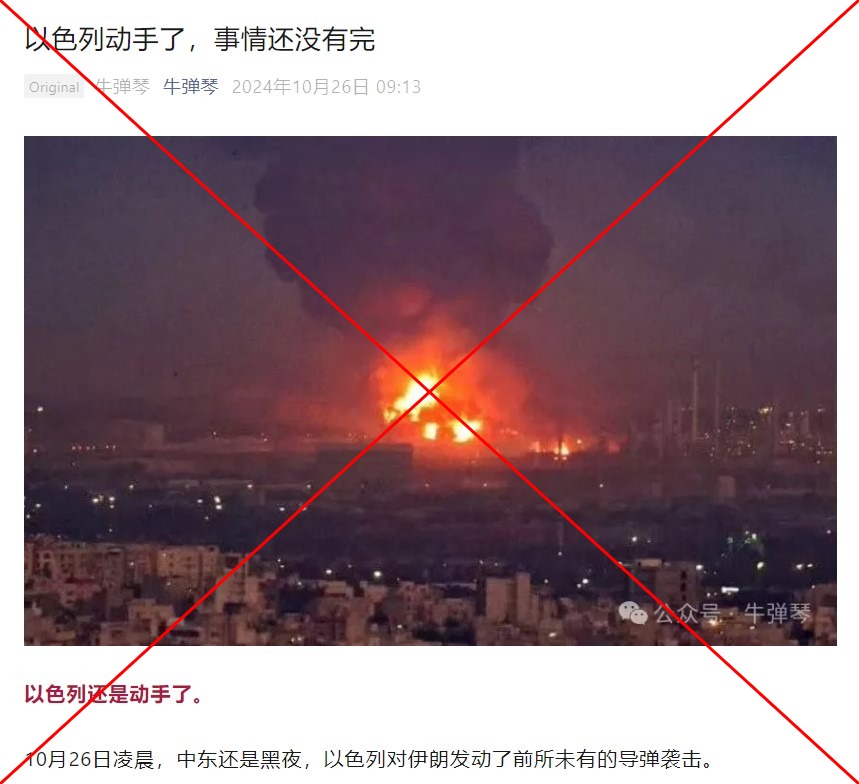On October 26, 2024, following a series of escalating tensions between Israel and Iran, Israel conducted significant air strikes targeting military installations across Iran. The strikes were primarily in retaliation for an earlier missile attack launched by Iran on October 1, which resulted in serious casualties in Israel, primarily among civilians. This exchange of military actions is reflective of the ongoing hostilities that have characterized Israel’s relationship with Iran and its various ally groups, notably Hamas and Hezbollah. Social media platforms quickly became a battleground for misinformation, with various posts incorrectly attributing images of a fire from a previous incident in June 2021 within an oil refinery in Tehran as evidence of the recent Israeli attack.
The misinformation campaign was amplified through simplified Chinese articles on platforms like WeChat, inaccurately depicting intense fires and smoke plumes as a result of Israeli strikes. Accompanied by alarming texts suggesting extensive damage to Iranian military capabilities, these claims sought to convey Iran’s vulnerability post-strike. However, evidence showed that the images being circulated were taken years prior and were misrepresented to imply recent military action. The backdrop of this incident signifies a continued pattern where historical events are repurposed to fit narratives of contemporary conflict, highlighting the challenges of discerning factual information in times of war.
A thorough investigation revealed that the images circulated in relation to the October 2024 strike were actually taken by renowned photographers Atta Kenare and Vahid Ahmadi, capturing an explosion at an oil refinery in Tehran on June 2, 2021. The cause of the fire was determined to be a leak from a liquefied gas line, as confirmed by officials shortly after the event. Despite ongoing speculation, no evidence of sabotage was found; it was purely a technical issue that resulted in a significant fire causing visible chaos across the skyline of Tehran. This retrospective examination underscores the importance of fact-checking and historical context, particularly when the stakes involve international relations and perceptions of military power.
Amidst the military engagements and misinformation, the broader atmosphere is set against a backdrop of heightened conflict throughout the Middle East, particularly between Israel and armed groups aligned with Iran, including Hamas in Gaza and Hezbollah in Lebanon. The tensions erupted significantly after Hamas’ deadly attack on October 7, 2023, which prompted relentless Israeli retaliatory strikes, claiming a tragic toll on Palestinian lives. Reports indicate that a substantial number of casualties have occurred as a result of this ongoing military confrontational dynamic, further complicating public perception and media portrayal of the conflict.
Social media platforms have often played a dual role: as a forum for real-time updates about the conflicts and as tools for disseminating misinformation. Misleading posts that leverage visual content can spread rapidly, inadvertently shaping public opinion without adequate scrutiny. The dissemination of misattributed images from previous events, as seen in the case of the Tehran refinery fire, can create confusion and perpetuate conflict narratives that further endanger accurate representation of events on the ground. Upholding accountability in media reporting, especially in volatile contexts, is fundamental to informing both local and international communities about the true nature, scale, and impact of military engagements.
In conclusion, the Israel-Iran conflicts represent a multifaceted and evolving geopolitical struggle marked by military operations and persistent misinformation. As social media continues to be a powerful communication tool, the need for critical engagement with information is more pressing than ever. The case of the falsely shared photos highlights the susceptibility of public narratives to manipulation in the digital age, ultimately calling for greater vigilance, fact-checking, and broader contextual understanding among audiences as they navigate the complexities of current events in the Middle East. Establishing a discerning framework for evaluating news sources could help foster a more informed public discourse while mitigating the impact of such disinformation campaigns on international perceptions and relations.

